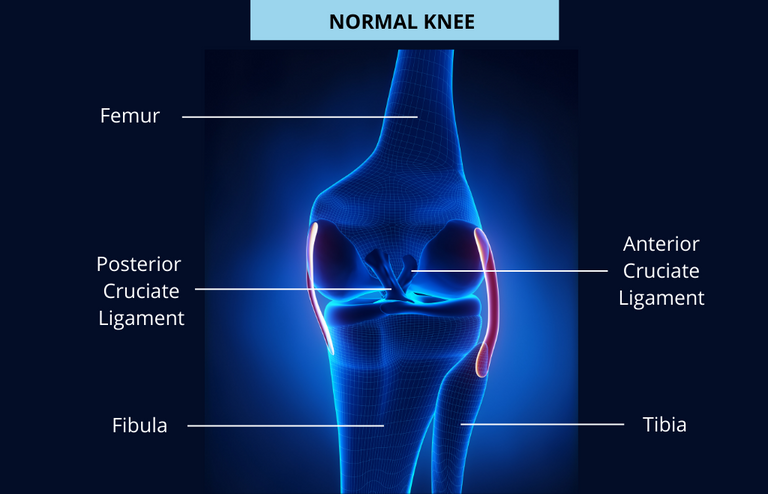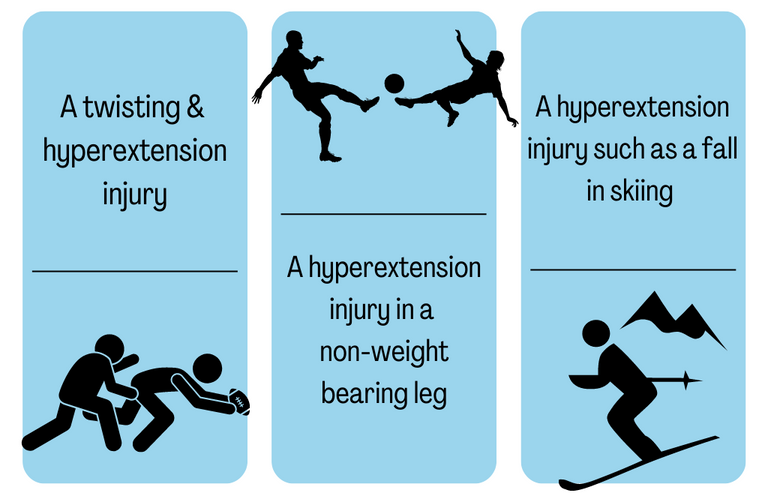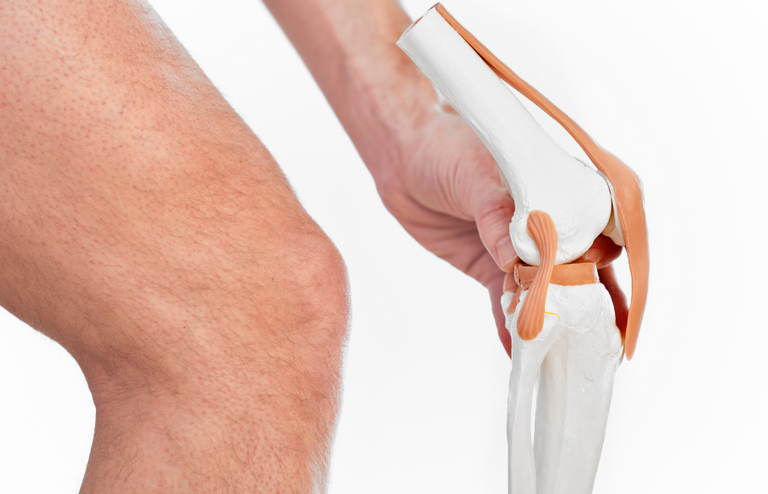Overview
Anterior Cruciate Ligament (ACL) is a strong band of tissue that runs diagonally in the middle of the knee which connects the thigh bone (Femur) and shin bone (Tibia). It is the key structure in the knee joint that prevents the tibia from sliding out in front of the femur, as well as provides rotational stability to the knee.
According to Larwa J, et al, the ACL is one of the most frequently injured structures that is common in young individuals during high impact activities or sports such as soccer, basketball, volleyball, gymnastic, skiing and football which is associated with decelerating, pivoting and jumping.

There are two types of ACL injuries:
Contact Injuries– this is categorized into two subtypes which are:
- Direct Contact Injuries: involves direct contact to the knee. For example, a direct blow to the knee can cause it to hyperextend and/or bend inward (valgus stress).
- Indirect Contact Injuries: involves physical contact with other body parts both before and during an injury.
Non-Contact Injuries: happen simply by doing the wrong movement. For example, when the athlete is trying to change directions, slow down or land from a jump.
A study published by the Orthopaedic Journal of Sports Medicine shows that in 140 ACL tears identified, 30% are from contact injuries and a whopping 70% from non-contact injuries, giving us a better understanding that non-contact injuries are more common. Cut-and-plant movement, incorrect landing from a jump, and sudden pivoting and twisting are the most common mechanisms of injury that contribute or lead to ACL tear.

How do you know when you have acquired an ACL injury?
When you suspect an injury, you would have normally heard an audible pop or crack, accompanied by excruciating pain. There will be widespread tenderness in the area, and depending on the severity of injury, there may be immediate and severe swelling. Inability to fully extend the knee at first, along with an initial instability or “giving away” sensation, especially when pivoting or rotating will be noted.
How to prevent it?
As the old saying goes, prevention is better than cure. With tons of injury prevention tips that are targeted to various injuries, Physiopedia recommends the following phases that you can apply to your daily routine prior to training sessions or games and incorporate as part of warm ups.
Phase I- Dynamic warm up
In a training program, the warm-up and cool-down phases are crucial. Stretching while “moving” or going through a joint’s full range of motion is referred to as a dynamic warm-up. The purpose of the dynamic warm-up phase is to significantly reduce injury risk while assisting the athlete in getting ready for activity.
Part II: Foundational strengthening
This program places a strong emphasis on strengthening the legs and stabilizing the knees. When performing these exercises, extreme caution must be taken to prevent injury; technique is everything.
Part III: Movement coordination, deceleration, cutting, and plyometric training
These exercises, which are explosive in nature, increase power, strength, and speed. When considering performance technique, the landing is the most important component. It has to be supple! After landing from a jump, shift your weight to the balls of your feet and slowly roll back to your heels while maintaining a bent knee and hip. These workouts are easy, but it is important to carry them out correctly.
The success of these prevention programs depends on dedication and time. Although there isn’t one program that can be hailed as the best exercise-based injury prevention program, there are many excellent online resources that can be used to put such programs into practice and support training. Overall, there is compelling evidence to suggest that these programs are highly effective at reducing the risk of ACL injuries. And as always, consult with your physiotherapist if you have any concerns regarding your body.

Written by: Reggie Arcilla
Reggie is an experienced physiotherapist using a range of physical techniques to improve mobility, flexibility, stability, strength and conditioning. He always read books to hone his professional growth. The patient’s pain-free smiles and expressions of gratitude makes him feels the most satisfied.
Sources:
Anterior cruciate ligament (ACL) injury. Physiopedia. (n.d.). Retrieved June 28, 2022, from https://www.physio-pedia.com/Anterior_Cruciate_Ligament_(ACL)_Injury#cite_note-:11-10
Anterior cruciate ligament (ACL) tears. Orthopedic Associates of Hartford. (n.d.). Retrieved June 28, 2022, from https://oahct.com/specialties/knee/anterior-cruciate-ligament-acl-tears/
Duthon VB, Barea C, Abrassart S, Fasel JH, Fritschy D, Ménétrey J. Anatomy of the anterior cruciate ligament. Knee Surg Sports Traumatol Arthrosc. 2006 Mar;14(3):204-13. doi: 10.1007/s00167-005-0679-9. Epub 2005 Oct 19. PMID: 16235056.
Larwa J, Stoy C, Chafetz RS, Boniello M, Franklin C. Stiff Landings, Core Stability, and Dynamic Knee Valgus: A Systematic Review on Documented Anterior Cruciate Ligament Ruptures in Male and Female Athletes. Int J Environ Res Public Health. 2021 Apr 6;18(7):3826. doi: 10.3390/ijerph18073826. PMID: 33917488; PMCID: PMC8038785.Takahashi, Saeko MS,∗; Nagano, Yasuharu PhD; Ito, Wataru PhD; Kido, Yosuke MS; Okuwaki, Toru MD A retrospective study of mechanisms of anterior cruciate ligament injuries in high school basketball, handball, judo, soccer, and volleyball, Medicine: June 2019 – Volume 98 – Issue 26 – p e16030 doi: 10.1097/MD.0000000000016030


